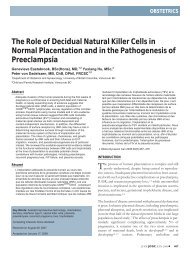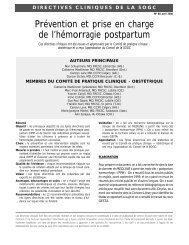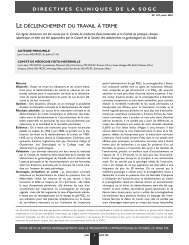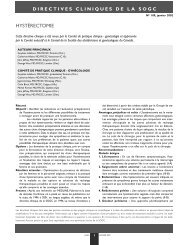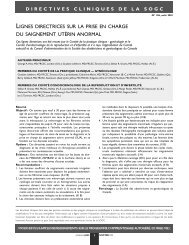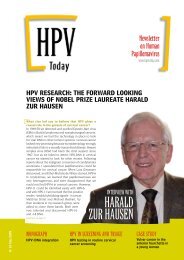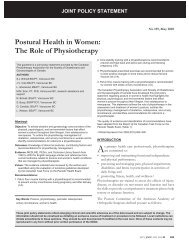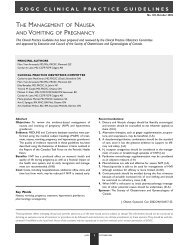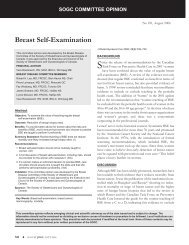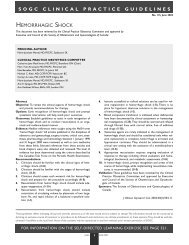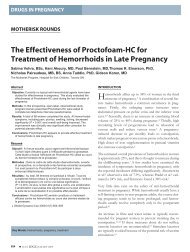Guidelines for operative vaginal birth - SOGC
Guidelines for operative vaginal birth - SOGC
Guidelines for operative vaginal birth - SOGC
Create successful ePaper yourself
Turn your PDF publications into a flip-book with our unique Google optimized e-Paper software.
OPERATIVE VAGINAL BIRTH<br />
Obstetrical-care providers frequently face dilemmas in the management<br />
of the second stage of labour. The decision as to<br />
whether or not a particular <strong>birth</strong> requires assistance and the<br />
choice and timing of any intervention must involve consideration<br />
of the risks of the potential techniques and the skills of the<br />
operator, as well as the urgency of the need to expedite the <strong>birth</strong><br />
process.<br />
Operative <strong>vaginal</strong> <strong>birth</strong> refers to <strong>for</strong>ceps- or vacuum-assisted<br />
delivery. Manual rotation, episiotomy, and, rarely, symphysiotomy<br />
can also be used to effect a <strong>vaginal</strong> <strong>birth</strong>. Caesarean<br />
section is the surgical alternative to <strong>operative</strong> <strong>vaginal</strong> <strong>birth</strong>.<br />
Experts often provide conflicting evidence <strong>for</strong> and against the<br />
use of these procedures. 1,2<br />
The literature discussing the use of vacuum and <strong>for</strong>ceps<br />
includes prospective randomized trials comparing the outcomes<br />
after <strong>for</strong>ceps- and vacuum-assisted <strong>birth</strong>. 3-6 These trials do not<br />
use the same inclusion criteria, the same instruments, or look<br />
at the same outcomes, making comparison of these 2 techniques<br />
difficult. Neonatal mortality and serious morbidity related to<br />
spontaneous <strong>vaginal</strong> <strong>birth</strong>, vacuum or <strong>for</strong>ceps, or Caesarean section<br />
have been reviewed in a large retrospective study. 7 None of<br />
these prospective 3-6 or retrospective 7 studies discuss specifics of<br />
the technique used <strong>for</strong> vacuum or <strong>for</strong>ceps procedures, the time<br />
required, or the criteria <strong>for</strong> abandonment of the procedure.<br />
The quality of evidence and classification of recommendations<br />
reported in this guideline have been described using the<br />
Evaluation of Evidence criteria outlined in the Report of the<br />
Canadian Task Force on the Periodic Health Exam (Table 1). 8<br />
INDICATIONS FOR OPERATIVE VAGINAL BIRTH<br />
Operative intervention in the second stage of labour may be indicated<br />
by conditions of the fetus or of the mother (Table 2). In<br />
Table 1<br />
Quality of Evidence Assessment 8 Classification of Recommendations 8<br />
The quality of evidence reported in these guidelines has been<br />
described using the Evaluation of Evidence criteria outlined in<br />
the Report of the Canadian Task Force on the Periodic Health<br />
Exam.<br />
I: Evidence obtained from at least one properly randomized<br />
controlled trial.<br />
II-1: Evidence from well-designed controlled trials without<br />
randomization.<br />
II-2: Evidence from well-designed cohort (prospective or<br />
retrospective) or case-control studies, preferably from<br />
more than one center or research group.<br />
II-3: Evidence obtained from comparisons between times or<br />
places with or without intervention. Dramatic results in<br />
uncontrolled experiments (such as the results of treatment<br />
with penicillin in the 1940s) could also be included in this<br />
category.<br />
III: Opinions of respected authorities, based on clinical<br />
experience, descriptive studies, or reports of expert<br />
committees.<br />
cases of non-reassuring fetal status, <strong>operative</strong> delivery may<br />
prevent hypoxic brain damage 9 or fetal death. 9 Maternal indications<br />
include congestive heart failure 9 or cerebral vascular mal<strong>for</strong>mations.<br />
9 Operative procedures may also be indicated <strong>for</strong><br />
inadequate progress in labour 9 ; in these cases, it is extremely<br />
important to ensure there is in fact adequate uterine activity. 10<br />
NON-OPERATIVE PRACTICES THAT DECREASE THE<br />
NEED FOR OPERATIVE BIRTH<br />
Several non-<strong>operative</strong> interventions have been shown to decrease<br />
the need <strong>for</strong> <strong>operative</strong> <strong>birth</strong>. One such intervention is the<br />
involvement of one-to-one <strong>birth</strong> attendants, who provide care<br />
during labour and <strong>birth</strong>. 11 Such attendants were described as<br />
experienced, continuously present, and able to provide physical<br />
and emotional support. 11 Hodnett11 assessed the role of the<br />
special support person in labour by reviewing 14 controlled trials,<br />
summarized in the Cochrane database, the results of which<br />
were all consistent despite a variety of obstetrical settings, hospital<br />
conditions, high- or low-risk pregnancies, and the differences<br />
in the professional training of the persons who provided<br />
the support. Using one-to-one <strong>birth</strong> attendants is a simple way<br />
to reduce the need <strong>for</strong> <strong>operative</strong> delivery. 11<br />
Monitoring the progress of labour and using oxytocin where<br />
progress is not adequate decreases the need <strong>for</strong> <strong>operative</strong> <strong>birth</strong>.<br />
Recommendations included in these guidelines have been<br />
adapted from the ranking method described in the Classification<br />
of Recommendations found in the Report of the Canadian Task<br />
Force on the Periodic Health Exam.<br />
A. There is good evidence to support the recommendation that<br />
the condition be specifically considered in a periodic health<br />
examination.<br />
B. There is fair evidence to support the recommendation that<br />
the condition be specifically considered in a periodic health<br />
examination.<br />
C. There is poor evidence regarding the inclusion or exclusion<br />
of the condition in a periodic health examination, but<br />
recommendations may be made on other grounds.<br />
D. There is fair evidence to support the recommendation that<br />
the condition not be considered in a periodic health<br />
examination.<br />
E. There is good evidence to support the recommendation that<br />
the condition be excluded from consideration in a periodic<br />
health examination.<br />
JOGC 748 AUGUST 2004<br />
Table 2. Indications <strong>for</strong> Operative Vaginal Birth<br />
Fetal<br />
• non-reassuring fetal status<br />
Maternal<br />
• medical indications to avoid valsalva (e.g., cerebral<br />
vascular disease, cardiac conditions)<br />
Inadequate progress<br />
• adequate uterine activity documented<br />
• no evidence of cephalopelvic disproportion<br />
• lack of effective maternal ef<strong>for</strong>t



